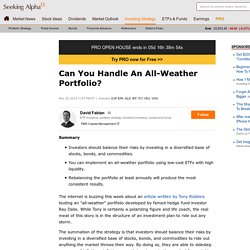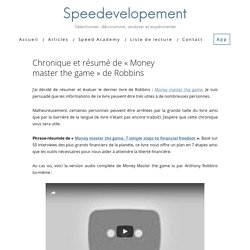

The White Coat Investor - Investing And Personal Finance for Doctors. As investors move from their investment childhood through the teenage years, many of them seem to almost become fixated on designing the perfect portfolio.

They’ve learned the importance of buy and hold, the importance of keeping costs low, and the importance of using passive investments over active ones. They learn about the efficient frontier, and seek to get themselves on to it, not realizing it can only be defined in retrospect. They start learning about various portfolios, and their pluses and minuses, and seem to be eternally seeking a better one.
Even some investment advisors fall into this trap, designing their own portfolios, borrowing someone else’s, or even paying to use someone else’s models. Occasionally, I even see investment advisors try to keep their model portfolios secret, as though theirs are somehow magically better than anyone else’s. The truth is that no one knows which portfolio is going to outperform in the future. Portfolio 1: The S&P 500 Portfolio Don’t laugh. Comment bien investir en bourse : les 10 meilleures stratégies - Objectif 10%
Comment bien investir en bourse ?

Comment investir en bourse sans risque ? Nous verrons dans cet article que cela n’est pas si dur que cela, à condition de diversifier ses actifs : Trop de diversification signifie en général une faible performanceTrop peu de diversification signifie en général un fort risque Nous allons donc, dans ce guide, analyser quelques unes des meilleures stratégies d’allocation. Les deux actifs les plus populaires sont les actions et les obligations : Les actions sont des parts d’entrepriseEt les obligations sont l’équivalent d’un titre de créance envers un Etat par exemple. The Low-Risk “All-Weather” Portfolio. Creating a properly diversified portfolio can be a difficult proposition, especially when interest rates have remained historically low for some time.

Now, suppose an investor is interested in that same diversified portfolio but would also like it to outperform in down markets. That’s certainly a tall order. Exchange-traded funds (ETFs) are one way to provide that diversification while reducing costs compared to other investments. Unlike mutual funds, ETFs will trade like stocks on an exchange and will fluctuate throughout the day. Their lower-than-mutual-fund fee structures make them attractive to investors. Asset Allocation Ray Dalio, founder of the investment firm Bridgewater Associates (and one of Time Magazine’s top 100 most influential people in 2012), created a portfolio that can weather almost any storm – because, as he puts it, you never know the environment your portfolio will be facing. 30% Stocks 40% Long-Term Bonds 15% Intermediate-Term Bonds 7.5% Gold 7.5% Commodities.
Can You Handle An All-Weather Portfolio? The internet is buzzing this week about an article written by Tony Robbins touting an "all-weather" portfolio developed by famed hedge fund investor Ray Dalio.

While Tony is certainly a polarizing figure and life coach, the real meat of this story is in the structure of an investment plan to ride out any storm. The summation of the strategy is that investors should balance their risks by investing in a diversified base of stocks, bonds, and commodities to ride out anything the market throws their way. By doing so, they are able to sidestep concerns of inflation, deflation, growth trends, and other cyclical forces taking a toll on their returns. He recommends a portfolio of 30% U.S. stocks, 15% intermediate-term treasury bonds, 40% long-term treasury bonds, 7.5% gold, and 7.5% commodities. The overweight nature of bonds is designed to counteract the volatility of stocks and commodities, which, he implies, is an area that many people take too much risk with. Concern #1: Investor Psychology.
Chronique et résumé de "Money master the game" de Robbins. J’ai décidé de résumer et évaluer le dernier livre de Robbins : Money master the game.

Je suis persuadé que les informations de ce livre peuvent être très utiles à de nombreuses personnes. Malheureusement, certaines personnes peuvent être arrêtées par la grande taille du livre ainsi que par la barrière de la langue (le livre n’étant pas encore traduit). J’espère que cette chronique vous sera utile. Phrase-résumée de « Money master the game, 7 simple steps to financial freedom ». Basé sur 50 interviews des plus grands financiers de la planète, ce livre nous offre un plan en 7 étapes ainsi que les outils nécessaires pour nous aider à atteindre la liberté financière. Au cas où, voici la version audio complète de Money Master the game lu par Anthony Robbins lui-même : Section 1 Bienvenu dans la jungle : le voyage commence par cette première étape Chapitre 1.1 C’est votre argent !
L’argent est une illusion. L’argent est un des moyens qui nous permet de transformer nos rêves en réalité.